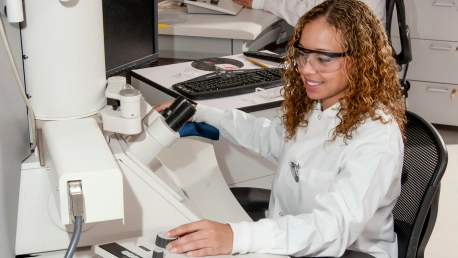The scientific realm teeters on the brink of a paradigm shift, where artificial intelligence (AI) teases the frontiers of possibility, promising a revolution in how research is conducted. As laboratories increasingly implement AI systems, the rush to harness this avant-garde ally begets a crucial conversation on the balance between innovation and the careful scientific method. This intricate dance between the eagerness for swift advancements and the foundational principles of meticulous scrutiny underpins the movement toward digital integration in the lab. Yet, with this transition looms the specter of overdependence and the dilution of diversity in scientific thinking. This article takes a measured look at both the remarkable possibilities and the potential pitfalls that accompany AI’s foray into scientific research labs.
The Spark of Debate: AI’s Experimental Triumphs and Trials
The announcement of a self-driving laboratory’s success in unearthing new materials, as reported in Nature, was a siren call to many in scientific circles. The AI-driven system, akin to a digital alchemist, seemed to promise an accelerated path to discovery. However, subsequent scrutiny revealed that errors may lurk within both the AI’s algorithms and the laboratory’s experimental protocols. Such revelations fuel skepticism and prompt a broader discussion about the dependability of AI in high-stakes research. Doubts crystallize around whether AI, in its current form, can be a reliable solo pilot in the voyage of scientific exploration, or if it remains an instrument necessitating vigilant human oversight. As AI whispers secrets of potential shortcuts to innovation, the scientific community grapples with the prudence of pacing its embrace within the hallowed halls of research.The ripples caused by AI’s purported triumphs extend beyond the initial cheers and into realms of critical contemplation. Should the fervor for progress outpace attentiveness to the rigor of results, the edifice of scientific advancement may rest on shaky ground. While AI presents a shimmering horizon of possibilities, it simultaneously imposes an imperative for heightened vigilance. Researchers must confront not only the capabilities of AI-driven systems but also their limitations and the repercussions of their integration.
AI: Accelerating Discovery or Fabricating Monocultures?
AI’s capacity to dissect and discern patterns within the sprawling data landscape grants it a powerful role in contemporary scientific methodology. Nonetheless, this bounty of data processing comes at a price, tempting researchers to lean heavily on AI’s perceived infallibility. The resultant concern is the advent of scientific monocultures—an environment where the diversity of heuristic approaches diminishes under the shadow of AI-driven homogeneity. The automation of experimentation promises efficiency and the reduction of human biases, yet it may also insidiously funnel science down a narrower corridor of inquiry.The impact of AI integration echoes through both individual understanding and collective research methodologies. On a personal level, researchers must grapple with AI’s opaque processes, often relegating comprehension to faith in mathematical machinations. Collectively, the diversity of problem-solving, a cornerstone of robust scientific progress, risks being compromised as AI systems, designed to optimize based on certain parameters, might overlook the serendipitous pathways of human intuition.
Setting Standards for Self-Driving Labs
The establishment of comprehensive standards is pivotal for the meaningful evaluation of AI-driven labs. Reports often gloss over or entirely omit vital information regarding the efficiency, longevity, and precision of self-driving laboratories. Without these metrics, the scientific community navigates blindly, lacking the necessary beacons to steer the credibility of autonomous experimentation.A consensus on performance metrics must emerge, one that includes crucial factors such as the degree of autonomy, operational lifetime, and the fidelity of experimental outcomes. By introducing these parameters, leaders in the field aim to underpin AI in science with a foundation of trust and empirical validation. Through these metrics, future developments can be guided, ensuring AI serves as an ally to scientific integrity rather than an uncharted variable in the equation.
Bridging Computational Know-how and Chemical Expertise
The confluence of computational algorithms and chemical knowledge heralds a new era of synthetic chemistry ripe with potential yet fraught with challenges. Collaborations between algorithm designers and chemists are essential to ensuring AI models are not only high-performance but also high-relevance. By marrying the intricacies of chemical expertise with the computational prowess of AI, a synergistic model emerges, one that enables AI to address the specialized demands of laboratory research.Model developers and synthetic chemists must stride together if AI is to reach its zenith of utility in the lab. This partnership promises to refine AI’s role, tailoring it to genuinely enhance the scientific process. A collaborative approach fosters a dialectic evolution of AI, ensuring that it evolves in service to chemistry’s complex needs rather than as a square peg forced into the round hole of laboratory life.
Trust, Accessibility, and the Future of Autonomous Labs
The evolution of autonomous experimentation in laboratories depends on trust: trust in the fact that results can be replicated, that the findings are reliable, and that there is a level of standardization across the board. Self-driving labs must demonstrate their worth through consistency and user-friendly interfaces to shift from being a curiosity to commonplace. Scientists must work to make these tools intuitive and cost-effective, ensuring they fit seamlessly into the research landscape.AI’s potential to revolutionize chemistry and material science is significant, yet its widespread adoption hinges on seamlessly integrating with the researcher’s workflow and meeting rigorous scientific protocols. Self-driving labs must win over the scientific community’s confidence by consistently proving their precision and reliability. As AI becomes more ingrained in laboratory settings, it brings both great potential and the need for cautious implementation. It should complement, not replace, human skill, and expertise. The future of scientific research with AI is bright, but it requires a careful balance to maintain the integrity and diversity of science. We’re at a pivotal moment, one where we must ensure the advances we pursue are thoroughly vetted, keeping science true to its core values while embracing new technological possibilities.









